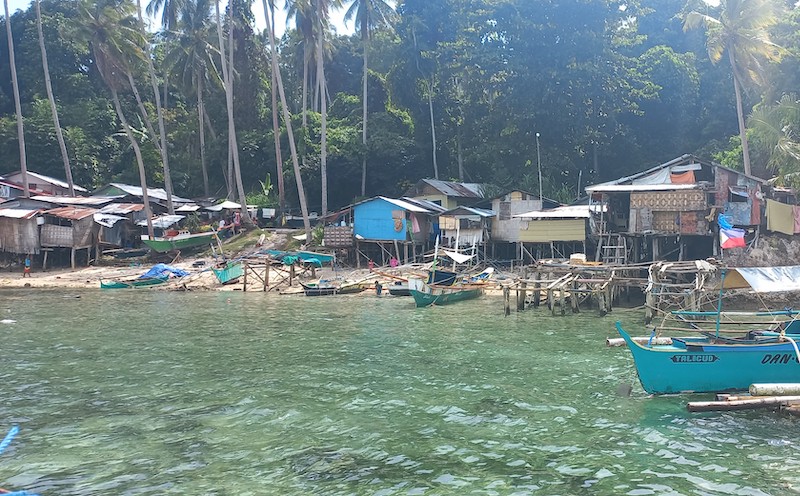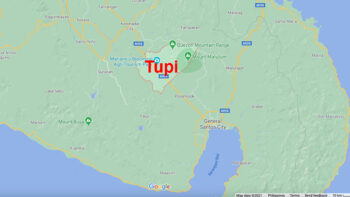ISLAND GARDEN CITY OF SAMAL (MindaNews / 16 Oct) — Despite the clear waters, a backdrop of green vegetation, and the romantic notion of an island, poverty dominates the village landscape. Some houses sit on stilts a few feet above the sea, others are constructed on a land settlement that measures less than a hectare. The houses are small, roughly three by seven meters, made of light materials and sheltered by tin roofs. Some appear to be falling down. On the shoreline are small and light motorized pump boats for fishing and ferrying passengers.

Sama Settlement in Talikud Island, Island Garden City of Samal. During the advent of Martial Law in 1972, a group of Sama from the island of Laminusa in Siasi, Sulu, migrated to this uninhabited coastal area in Samal Island, Davao del Norte, and established a small settlement which is now threatened with displacement. MindaNews photo by JULES L. BENITEZ
The place has no name, but those who live here call it “Muslim Community” and refer to themselves as jama’a (an Arabic term that denotes a group or a congregation). The small village of 42 households is located in Barangay Sta. Cruz in the island of Talicud, off the coast of Samal Island in Davao del Norte.
“I grew up, got married, and had children here,” the 62-year old Babu (elderly woman) Lapid Adlawan narrated. “Now, I have several grandchildren here. Can we not call this our home?”
From Sulu to Samal
Babu Lapid was barely 12 years old when she and her family sailed to Talikud Island to flee the war spreading in the province of Sulu during the advent of Martial Law in 1972. Along with them were two other families. They came from the island of Laminusa in Siasi, Sulu and refer to themselves as Sama-Laminusa.
She recalled: “Mahirap ang buhay doon. Palaging may putukan. Hindi makahanapbuhay ang aking mga magulang, kaya grabe ang gutom.” (Life in Laminusa was difficult. Gunfights were frequent. My parents had no source of livelihood so we experienced extreme hunger).
Babu Lapid’s family and their companions decided to establish their community along the coast of Talikud Island in 1972, then occupied only by a few inhabitants. The area also resembled the marine ecosystem of Laminusa, thus facilitating their immediate adaptation to the new environment.
 Community Peace Mediator Babu Lapid Adlawan (R) was 12 years old when her family migrated to Talicud Island. Trained as a peace mediator by forumZFD, she now leads her community in negotiating for their right to live in their 51-year coastal settlement. MIndaNews photo by JULES L. BENITEZ
Community Peace Mediator Babu Lapid Adlawan (R) was 12 years old when her family migrated to Talicud Island. Trained as a peace mediator by forumZFD, she now leads her community in negotiating for their right to live in their 51-year coastal settlement. MIndaNews photo by JULES L. BENITEZ
The next 20 years in their new home went peacefully. The men fished and the women wove colorful mats. They sold the produce to nearby communities. Their number expanded through inter-marriage. In those days, Talikud Island and the nearby Samal Island were considered rural areas and resorts were unheard of.
“Mao na kini ang akong kagikan kay diri na man ko natawo, (I consider this my home, as this is my birthplace.)” said Sitte Alimudin, 23, a fresh graduate of Bachelor of Science in Elementary Education. Of the roughly 400 individuals in their jama’a, Sitte is the only one who finished a college degree.
“Poverty is the main reason why my siblings and the other youth in the community are not able to finish schooling,” she said in Cebuano, the dominant language in the area. While education is free, the cost of transportation and daily balon (packed meal) is still prohibitive for this small community.
“My community needs livelihood assistance for us to be able to send the children to school and, perhaps, get out of poverty,” Sitte said.
Luckily for Sitte, her mother, Mamba Alimuddin, 64, made sure to save money for her education, from the income she derived from mat weaving.
Talikud’s mat weaving is a heritage from their place of origin, Laminusa in Sulu, a town famous for its colorful Laminusa mats.
The mat designs and weaving technique of the community is a tradition that the older women learned from their forbears. Like the Laminusa mats, the strands used for weaving are finely stripped to about two centimeters and dyed to various colors. The material used is from the pandan leaves. It takes a month for a weaver to finish a family-sized mat.
Noticeably, the designs of the Talikud mat weavers differ from those being woven today in Laminusa, Sulu, in terms of colors and the intricacy of design. Possibly, this is due to difficulty in getting the right dyes. Moreover, being isolated from the source of the designs, the weavers here lagged behind the innovations in the Laminusa mat weaving. The migrant weavers have not been able to visit their place of origins since they set foot here.
A single-sized mat, about four by seven feet, is sold for P3,000. A family-sized mat is sold for P5,000.
The mats are considered indigenous work of art.
Weaving Peace
Samal Island’s conversion into the Island Garden City of Samal in 1998 and its proximity to Davao City were plus points in turning the area into a tourist destination. The succeeding years saw the rapid establishment of beach resorts, occupying most of the 18-kilometer coastlines and the cluster of nine islets surrounding it. The locals sold lands to resort investors in a frenzy. Talikud Island was not spared.
According to the City Tourism Office there are total of 120 big beach resorts, 39 Mabuhay resorts (small resorts), and 19 inland resorts in Samal Island as of 2023.
In 2022, when the COVID-19 restrictions had eased, there were 779,750 tourist arrival in Samal Island. From January to May, 2023, tourist arrival slowed down to 56,456 arrivals. The Tourism Office projected an increase in the tourist arrival in the months of June to August, which is considered as the peak months for the local tourism.
 With skills learned from their forbears, these Sama women make an earning weaving colorful and intricately-designed mats. Considered a work of art, the family-size mats are sold for P5,000 apiece. Photo by JULES L. BENITEZ
With skills learned from their forbears, these Sama women make an earning weaving colorful and intricately-designed mats. Considered a work of art, the family-size mats are sold for P5,000 apiece. Photo by JULES L. BENITEZ
Amid the growing tourism activity, Babu Lapid’s jama’a is facing uncertainty over threats of being uprooted from the small settlement they have occupied for half a century. A nearby resort has claimed occupancy rights of the surrounding coastal areas, including Babu Lapid’s jama’a.
“Pinapaalis na kami dito dahil gagamitin daw nila ang lugar namin,” (We have been asked to leave our place because they are going to use this area.), Babu Lapid said.
As a second generation elder of her jema’a, Babu Lapid is concerned about her people and their future. “Iniisip ko kung paano ko kakausapin ang may-ari ng resort,” (I am pondering how I will negotiate with the resort owner) she said.
Babu Lapid has recently completed a course on non-violent conflict resolution conducted by the Forum Zivilier Friedensdient e.V or locally known as forumZFD, a German non-government organization striving to overcome war and violence around the world. The course is dubbed “Bugsay Series,” from the Cebuano word “bugsay,” which means to row the boat, an analogy of peacebuilding as a journey. Through the four-phased training, she gained skills in non-violent communications and the process of peaceful negotiation to address community conflicts.
“Nagamit ko yung natutunan ko sa Bugsay upang ayusin ang mga alitan sa pagitan ng mga tao sa aming jema’a,” (I applied what I have learned in Bugsay, to resolve the internal conflicts among the members within my Jemaah.) However, in the face of displacement threats coming from a rich resort owner, Babu Lapid feels unsure about her ability to facilitate such serious concern.
Even with her training on peace mediation, Babu Lapid said, “Meron akong kaba sa aking dibdib kung kakayanin ko ba na makikipag-usap sa may-ari ng resort.” (I feel unsure if what I have learned will suffice in negotiating with the resort owner.) She is, however is hopeful that a peaceful mediation will resolve their claim for a settlement by the sea.
“Sana makita nila na ang aming kakayahan sa paggawa ng banig at pangingisda ay pwede ring maging bahagi ng turismo,” (I hope they will realize that our skills in mat weaving and in fishing can be part of local tourism), she said.
Babu Lapid intends to leverage these community talents and skills to negotiate and seek better living condition for her jema’a.
October: Indigenous Peoples’ Month
Rexall Kaalim, 54, chair of the Samal Island Muslim Communities Development Center, Inc. (SIMCDC), a conglomeration of elders from various jema’a in the island, expressed alarm over the cases of displacement of Indigenous Peoples happening unnoticed amid land prospecting and expansion of tourism in the island.
Kaalim, a peace worker involved in various peace initiatives in Mindanao wants the National Commission on Indigenous People to look into these cases.
“The case in Talikud is just one of several cases that SIMCDC is monitoring and assisting,” said Kaalim, who is himself a member of an indigenous community in Samal.
Shores or beaches all throughout the country are public property, according to the Law of Waters of 1866, Article 339 of the Civil Code of the Philippines, and the Fisheries Decree of 1975.
Kaalim said the practice of resort owners to occupy the coastal areas, which are considered public land, has been tolerated by the City Government. “The resorts just pay a fine of few thousand for such violation, which deprive people free access to the coastal land and resources,” he said.
 Map courtesy of Google
Map courtesy of Google
Atty. Eleazar E. Lape, City Planning and Development Officer of Samal Island, said the Comprehensive Land Use Plan (CLUP) of Samal Island expressly prohibits the resort encroachment of the shoreline in accordance with national laws. He said resort owners pay as much as P100,000 per year as fine for the illegal structures on the shoreline.
“The City Government, following the current CLUP, granted a five-year moratorium for resorts owners on the occupation of the shorelines and the construction of jetty ports (a long, narrow structure that appear to subdivide the coastlines among resorts),” Lape said. He added that the moratorium will expire in 2024.
Lape said the mat weavers of Talikud Island can seek assistance from the City Government.
Rosabel V. Jusguan, City Tourism Officer, said they are encouraging resorts to free the coastal shore of illegal enclosures. Jusguan cited an example set by the barangay government of Panggubatan where, by virtue of a barangay ordinance, the prohibition of resort encroachment on the shoreline was enforced.
“As the country observes the Indigenous Peoples’ Month this October, it is but appropriate that the national government should find solution to the displacement of our people,” Kaalim said.
The NCIP is spearheading the 26th anniversary of the signing of Republic Act 8371 or the Indigenous Peoples Rights Act on October 29. October is IP month and this year’s theme is “Pagpapayaman ng Pamanang Kultural at Katutubong Yaman Tungo sa mas Maliwanag na Kinabukasan para sa Bagong Pilipinas (Enriching the Cultural Heritage and Indigenous Tradition towards a Brighter Future for New Philippines).” (Jules L. Benitez/MindaNews)
